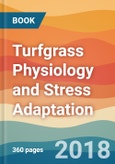Divided into four sections, the book begins with an introduction to warm–season and cool–season turfgrass species. Other key topics include a comprehensive discussion on physiological and metabolic processes controlling turfgrass growth and development, an examination of the ways turfgrass plants cope with environmental stresses, and the potential role biotechnology will play in enhancing turf in the future. Aimed primarily at turfgrass educators, scientists, practitioners, and students, Turfgrass Physiology and Stress Adaptation is an invaluable tool for anyone interested in turfgrass science and management.
Table of Contents
I. Principles of Growth and Development of Turfgrasses.Chapter 1: Characteristics of turfgrass species.
1. Warm–season grass.
2. Cool–season grass.
Chapter 2: Dynamics of growth and development.
1. Leaf production and senescence.
2. Root initiation, growth, and senescence.
3. Flower formation and seed production.
II. Physiological and Metabolic Processes.
Chapter 3: Water relations.
1. Transpiration or water use.
2. Water uptake of the root system.
3. Environmental factors affecting water use and water uptake.
Chapter 4: Carbon metabolism.
1. Photosynthesis.
a. C–3 pathway.
b. C–4 pathway.
c. Plant and environmental factors influencing photosynthesis.
2. Respiration.
a. Aerobic respiration.
b. Anaerobic respiration.
c. Plant and environmental factors influencing photosynthesis.
3. Carbohydrate storage and utilization.
Chapter 5: Mineral nutrition.
1. Function of essential nutrient elements (macro– and micro–nutrients).
2. Deficiency symptoms of major nutrient elements.
3. Uptake and metabolism of major nutrient elements.
4. Factors influencing soil nutrient availability and nutrient uptake.
Chapter 6: Phytohormones and plant growth regulators.
1. Phytohormones.
a. Abscisic acid.
b. Cytokinins.
c. Gibberellins.
d. Auxin.
e. Ethylene.
2. Plant growth regulators.
a. Growth inhibitors.
b. Biostimulants.
III. Plant responses to environmental stresses.
Chapter 7: Drought.
Chapter 8: Flooding.
Chapter 9: Heat.
Chapter 10: Cold.
Chapter 11: Light.
Chapter 12: Soil physical and chemical property.
1. Salinity.
2. pH.
3. Compaction.
IV. Biotechnology and breeding.
Chapter 13: Molecular aspects and genetic manipulation for improving turf traits and stress tolerance








